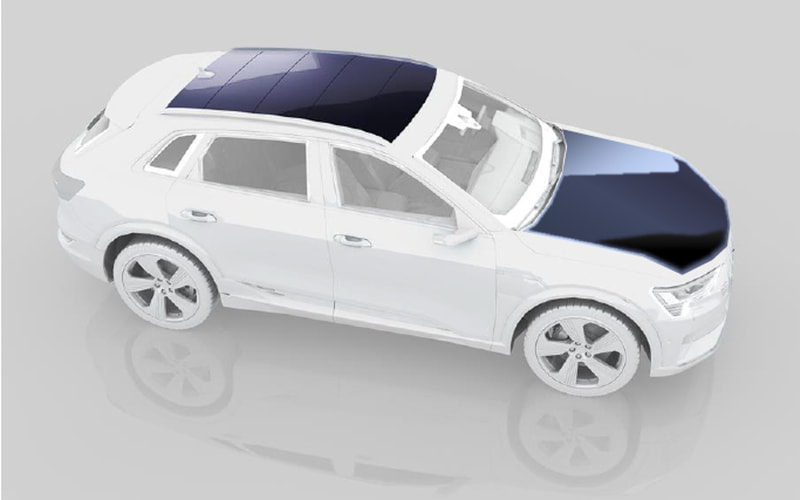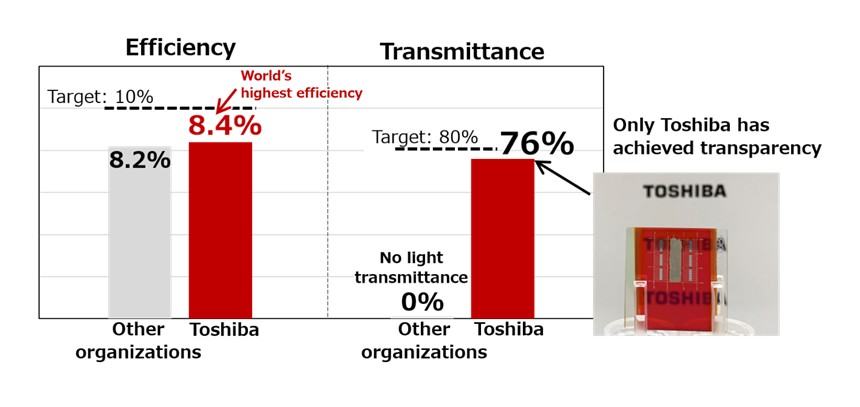

東芝:透過型Cu2O太陽電池:充電なしで35km/1日走行(動画):
Toshiba: Transmissive Cu2O solar cell: 35km / day without charging:
东芝:透射式Cu2O太阳能电池:35公里/天不充电
ー無充電EVの実現に貢献ー
ー1度も充電せず、EVを乗りまわせる時代ー
東芝:
12月22日、新たな「透過型亜酸化銅(Cu2O)太陽電池」を開発したと発表した。
Cu2O太陽電池:
「発電層の不純物を抑制することで、世界最高の発電効率」の8.4%を実現した。
充電なしでの航続距離:
この太陽電池をEVに搭載した場合、
- 充電なしでの航続距離は、
- 1日あたり約35kmに達すると試算。
- 将来的には1日あたり約40kmの走行が可能になる。
1度も充電せずに走行:
- 走行で消費した電気を、
- 太陽光発電で蓄電池に補充すれば、
- 長距離の走行が可能になる。
EVを購入したら、1度も充電をせずに走行し続けることができる世界を目指すという。
Cu2O太陽電池の特長:
低コストで高効率なタンデム型太陽電池に向け、活用が期待されている。
タンデム型太陽電池とは:
- 2つの太陽電池セルを、
- ボトムセルとトップセルとして重ね合わせ、
- 両方のセルで発電する。
全体としての発電効率を上げるのが特徴だ。
高効率トップセルの開発:
2019年に、世界で初めてトップセルとして、透過型Cu2O太陽電池を開発。
既存のSi太陽電池などを重ねて利用することで、
低コストで高効率なトップセルの開発が可能になることを示した。
透過型Cu2O太陽電池:
銅と酸素の化合物であるCu2Oが主な材料。
- III-V族半導体と比べて、
- 基板、原材料、製造装置はいずれも安価で、
- 大幅な低コスト化が期待できる。
東芝 研究開発センター
ナノ材料研究所GaAsタンデム太陽電池を、自動車に搭載した場合、2000万円かかる。
- 車体価格をはるかに上まわってしまう。
- 幅広く活用するには大幅なコストダウンが必要。
そこに、透過型Cu2O太陽電池が貢献できる。
Si太陽電池をボトムセルに用いる
透過型Cu2O太陽電池は、
短波長光を吸収して発電し、長波長光を透過する構造となっている。
- 長波長光で発電するSi太陽電池をボトムセルに用いることで、
- 短波長から長波長まで幅広い波長の光を、
- エネルギーに変換することができる。
– Car Watch
https://car.watch.impress.co.jp/docs/news/1376121.html
Toshiba’s Transparent Cu2O Tandem Solar Top Cell Achieves 8.4% Efficiency
-A boost to development of no-plug charging EVs and transition to renewable energy-
Corporate Research & Development Center
Toshiba 22 December, 2021
Toshiba Corporation TOKYO
today announced that it has successfully raised the power conversion efficiency (PCE) of its transparent Cu2O solar cell to 8.4%,
the world’s highest level for a reported Cu2O solar cell(*1).
With the cell positioned as the top cell over a 25% PCE silicon cell (Cu2O-Si tandem cell),
Toshiba estimates that an overall PCE of 27.4% can be achieved,
notably above the 26.7% highest PCE reported for any standard silicon cell(*2).
Under the test criteria defined by Japan’s New Energy and Industry Technology Development Organization (NEDO),
Toshiba estimates that
the Cu2O-Si tandem cell will carry an EV 35km without any need of recharging. Looking ahead,Toshiba expects
the new cell to boost development of EVs with no need for plug-in charging, and to advance other mobility applications,such as the High Altitude Platform Station (HAPS), the telecom platform in the stratosphere.
https://www.global.toshiba/ww/technology/corporate/rdc/rd/topics/21/2112-02.html